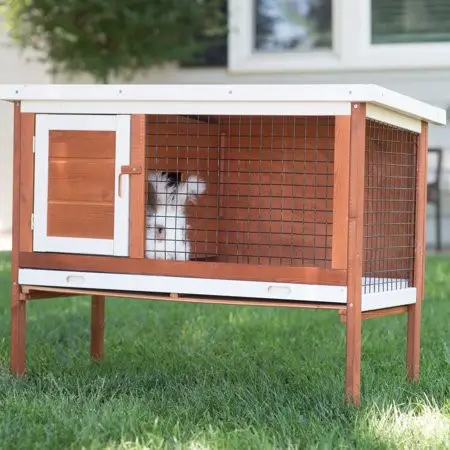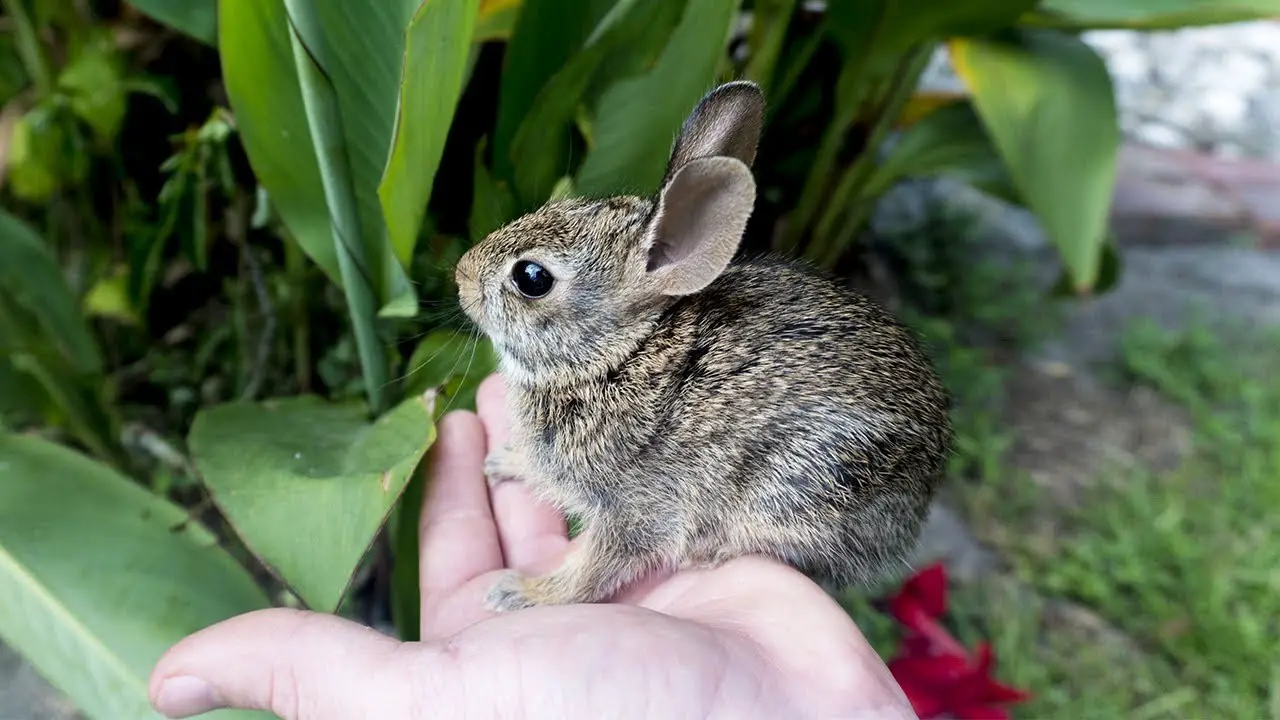Scientific Facts
| Common Name: | Robust Cottontail |
| Scientific Name: | Sylvilagus robustus |
| Life Span: | 3 years in the wild, up to more than 8 years in captivity |
| Size: | About 16 inches |
| Habitat: | Mountain regions |
| Country of Origin: | The Southern United States and Northern Mexico |
Robust Cottontail Information
The Robust Cottontail is a species of cottontail rabbits that can commonly be found in the mountainous regions of Southern United States (mostly near the Rio Grande River in New Mexico and the East Pecos River in Texas) and in the northern regions of Mexico (areas bordering the country and that of the United States). The Robust Cottontail used to be considered a subspecies of the Eastern Cottontail rabbit but has since been considered its own unique species due to morphological differences between it and the Eastern Cottontail. Nevertheless, the Robust Cottontail rabbit still retains some of the features that are commonly found in most species of cottontails.
Physical Description

Robust Cottontails are a lot similar to other types of cottontail rabbits but have their own unique and distinctive physical attributes. This species of the rabbit is often dominated by a grayish color in terms of its overall appearance. Its back may sometimes look different compared to the rest of its body, as it is usually light gray in color. However, there are some instances where certain Robust Cottontails may look closer to a lighter shade of brown than gray. There are also times when some Robust Cottontails are mixed with gray and light brown colors. Nevertheless, the light brown or grayish color will most often transition into a darker color down the back of the rabbit.
Often times, the Robust Cottontail will also have light brown fur at the back of their necks.their shoulders are also predominantly brown regardless of whether or not the rest of the rabbit’s body is brown or gray. Their tails also differ from the rest of the body in terms of its color, as you can clearly see that the top fur is brown but are actually white underneath.
Like most other cottontail rabbits, the Robust Cottontail has large ears that can sometimes even be longer than the entire length of its head. The ears can sometimes have darker fur lining the sides but are usually of the same color as what dominates the rest of the rabbit’s entire body. Similarly, like most cottontails, the Robust Cottontail also has large feet that may even be just as long as their ears. The feet are also very furry.
Often mistaken as subspecies of the Eastern Cottontail, Robust Cottontails may look a lot like their cousins but have certain physical differences. Robust Cottontails are actually bigger than their eastern cousins. Their skulls are also shaped differently and are naturally bigger than the Eastern Cottontail´s skull.
Personality
The one thing about the Robust Cottontail’s behavior in the wild is that they are pretty difficult to find. In the past, they were considered to be just a subspecies of the Eastern Cottontail and have been grouped together with them. But since getting their own unique identity as a separate species, Robust Cottontails have become quite difficult to find in the wild as they are no longer grouped by scientists together with their eastern cousins.
However, there are reasons to believe that the Robust Cottontail have personalities and habits that are a lot similar to the Eastern Cottontail due to being very closely related and due to having the same kind of habitat. For one, these rabbits are quite solitary and prefer to be left alone. These cottontail rabbits will most likely only congregate with one another or group with their other fellow Robust Cottontails when it is mating season. Aside from that, you will most likely notice that Robust Cottontails like living and spending their time alone than in a group.
Robust Cottontails are similar to their Eastern Cottontail counterparts in the sense that they are actually nocturnal rabbits. They are active during the periods between dusk and dawn and are most likely asleep in their hideouts or burrows during the day. The reason for this is that the natural predators of these rabbits are diurnal hunters. So, to keep away from predators, Robust Cottontails only come out during the dark when most diurnal hunters are already inactive.
Unlike some other solitary animals, Robust Cottontails are not territorial in nature. They do not mind sharing the same kind of travel and feeding territory with some other rabbits. Females during the breeding period tend to be the only exception to this general rule. There is no certainty as to the size of a Robust Cottontail’s territory as it really depends on the living conditions of the area.
While Robust Cottontails may be solitary creatures, they still do need to communicate with one another. Most of these rabbits use their sense of smell to communicate with other Robust Cottontails as they rarely make sounds. Probably the only time when a Robust Cottontail makes a sound is when it releases a high-pitched squeal, which is a unique signal it uses when it is attacked by a predator. And when they are trying to warn an incoming threat, they drum their feet strongly and loudly to make an intimidating sound.
When a wild Robust Cottontail lives too close to human settlements, they might damage orchards and farms when they are looking for food. However, Robust Cottontails living near humans can be somewhat rare as these are shy rabbits that try to live in solitary in mountainous places and more than likely prefer to be kept hidden away from humans.
In captivity, Robust Cottontails usually have a tamed personality and are most likely very behaved so long as they are given the proper type of living conditions and a diet that is suitable for their kind. Robust Cottontails are not as common as Eastern Cottontails, but they are pretty receptive to human care and are more than likely just as receptive to getting cared for by humans. There have been instances where baby robust Cottontails get orphaned (due to man-made or natural reasons) and have no problem getting adopted by humans.
Life Span
Robust Cottontails are not the most resilient and hardy types of rabbits. These bunnies only get to live for about 3 years when left alone in the wild due to a lot of factors that include illnesses, bacteria, and other types of infections, environmental changes, deforestation, and natural predators.
Meanwhile, captive Robust Cottontails are more than likely able to live much longer than their wild counterparts. That is because they usually live in environments that are less likely to put them at risk of different types of illnesses and infections. Moreover, their diet in captivity tends to be healthier so long as the owner knows what he or she is doing. In that sense, there is no reason why captive Robust Cottontails will not reach at least 8 years of age.
Reproduction
Robust Cottontails may have similar breeding habits to other cottontail rabbits, but they tend to reproduce in areas that are elevated due to the fact that they live in elevations that are higher than their counterparts. Normally, these rabbits are quite solitary in terms of their natural behavior, but they tend to change that part of their behavior when they are reproducing.
Male Robust Cottontail rabbits tend to have a more dominant approach when it comes to breeding. In social systems, the more dominant males often try to bully smaller and weaker males into winning the right to reproduce with a healthy female. In that sense, male rabbits can be quite aggressive and will more than likely fight with one another to tell who is the more dominant Robust Cottontail.
Courtship in Robust Cottontail rabbits usually happens at night. They often try to win the affections of a female not only by displaying their dominance over other male rabbits but also through certain bodily gestures that can attract the female’s attention. Neither the male nor the female Robust Cottontail are monogamous as it is common for either of them to mate with more than one partner.
Due to how quick Robust Cottontails develop in the womb of their mothers (usually around less than a month), female rabbits can have five sets of babies in a single calendar year. Most female Robust Cottontails can have 3 to 5 babies per set.
Eating Habits
Like any other cottontail rabbit, the Robust Cottontail only eats plants and is regarded as a strict herbivore in terms of its diet. However, it is not that they only prefer to eat plants; it is just that they can actually only eat plants due to how their teeth are made for gnashing and crushing plants and grains rather than for slicing and cutting through flesh and meat.
The diet of the Robust Cottontail depends on what is actually available in its immediate environment or surroundings. Most of the time, these rabbits eat almost any kind of grass around them so long as it is edible enough for cottontails. There are also times when they prefer to mix their diet up by adding edible flowers to their regular meals. But, when grass or other flowering plants are not as common during the winter season, Robust Cottontails change their diet and will most likely eat twigs and small trees.
In captivity, Robust Cottontail can thrive well when given a diet that is based on vegetables and greens. Giving them leafy greens such as lettuce and spinach can be a good idea as these vegetables are rich in vitamins and nutrients and are much better than the grass that these rabbits are used to in the wild. You can also provide your Robust Cottontail with a diet that is based on other types of vegetables such as carrots, squash, and beans. At times, it might also be a good idea to feed them with grains such as oats and rice, but it still always is better to base your Robust Cottontail’s meals on a diet that is primarily composed of leafy greens and other nutritious vegetables.
Cottontails are known to eat their own dung, but there is no certainty as to whether Robust Cottontails eat theirs. To be safe, it is best to make sure that you put your Robust Cottontail in a cage where they will not be able to reach their own fecal matter to minimize the possibility that they will eat their dung. Fecal matter may be a regular part of most cottontails’ diet, but they can also be full of bacteria, parasites, and harmful organisms.
Due to how the Robust Cottontail’s diet in captivity is much more nutritious than it is when they are in the wild, it is expected that these rabbits will be able to strive better in captive care and will get to live a life span that is almost more than twice of that of their wild counterparts.
Water
Robust Cottontails are like any other rabbit in the sense that they will need to drink water on a regular basis to keep themselves hydrated. In that sense, the best way to keep your rabbit hydrated is to place a large enough water dish in their cage. But because water dishes are more than likely susceptible to getting infected, you may opt for a fountain-like hydration system that keeps the water away from exposure. This ensures that the water stays clean and fresh. However, you can still use a water dish but always be vigilant enough to replace the water and to clean the entire dish from time to time to minimize the risk of bacteria, parasites, and other types of infections.
Cage

A Robust Cottontail can be placed in any type of cage that is big and sturdy enough for this type of rabbit. You may want to go for a wooden cage that has steel grills to make sure that it has enough durability. Always see to it that the cage has a roof on top of it if you are planning to house your Robust Cottontail in an outdoor environment. You may opt for a cage that can only be seen through a few sides, or you may want to use one with only one side that is see-through. However, it is important for the cage to have an opening that can only be securely opened from the outside.
Since the Robust Cottontail can be quite the big rabbit, you can go for a cage that has enough space for this animal to walk around in. It may be a good idea to buy or make a cage that is at least 3 feet long and 2 feet high to give the Robust Cottontail more than enough room. The width should not be too much of an issue so long as it is at least more than one and a half times wider than the length of your rabbit.
The cage of a Robust Cottontail should have a catch basin bellow a grilled flooring to serve as a way to separate the rabbit’s fecal matter from itself. This does not only make clean-ups easy for you, but it also ensures that the Robust Cottontail is not in close contact with its feces as they do have a tendency to eat their own dung.
Decorations and furnishings in your Robust Cottontail’s cage might not be essential, but you can provide your rabbit with large rocks or with tree barks to give it some sort of security as it can have a few spots it can use for hiding.
Availability – Where to Get One?
Robust Cottontails are not as common in pet shops or in the online pet trade industry as their other cottontail counterparts are. Nevertheless, you may still get your hands on these rabbits if you look hard enough online or if you ask for references from pet stores that sell other species of cottontail rabbits. Even in the wild, it can be pretty difficult to find a Robust Cottontail as they are not as abundant as their Eastern Cottontail counterparts. In that case, these are not as readily available as some other pet rabbits are.
How to Care for a Robust Cottontail?

Robust Cottontails are not entirely very difficult to care for as long as you know what rabbits usually prefer in terms of minimum care and nutritional needs. These cottontail rabbits tend to be quite docile or submissive in terms of their nature but are nonetheless still unique in their own way due to how they prefer to live a lifestyle that is solitary. That means that you do not always have to give them attention and that you do not always need to play with them. In fact, most cottontail rabbits prefer to be left alone and are best kept in environments that allow them to live a solitary lifestyle. Avoid housing more than one Robust Cottontail in the same cage, although they are not very territorial in terms of their nature.
Feeding a Robust Cottontail is quite easy as well because you know that these rabbits prefer to eat leafy greens and vegetables due to how they tend to eat grass, twigs, and bark in the wild. Feeding them with healthy leafy greens give them the health benefits and nutritional qualities they almost never get in the wild when they are only eating grass and flowering plants. You can also supplement their diet with vegetables and grains if you want but always make sure that their regular meals are based on leafy greens.
Robust Cottontails are not as hardy and as resilient as other animals. In that sense, always see to it that they are placed in an environment that is suitable for them. A cage with more than enough space is a good way to start. Make sure that the rabbit’s cage is as clean as possible so as to minimize the risk of them suffering from all types of infections that can very well shorten their lifespan.
FAQs
What food should I feed my Robust Cottontail?
Robust Cottontails prefer to feed on grass and leafy greens and vegetables such as lettuce, spinach, and even carrots.
Are Robust Cottontails ideal pets?
Robust Cottontails are quite easy to take care of because they are not particularly demanding types of rabbits. In that sense, they are ideal pets to have as long as you know how to give them the minimum care they deserve.
Can you play with Robust Cottontails?
The Robust Cottontail rabbit is not the most playful type of cottontail outdoor and is quite docile and submissive to its owner. They might not play with you, but they will allow you to handle them from time to time without much struggle.
Can you house two ore more Robust Cottontails in the same cage?
Robust Cottontails may prefer to be left alone to live a life of solitude, but they are not territorial rabbits and will not attack their own kind if they live in the same territory. That means that it can be safe to house more than one of these rabbits in the same cage but always keep in mind that the Robust Cottontail prefers to live alone than with others.
Can Robust Cottontails eat meat?
Robust Cottontails are like any other cottontail rabbit in the sense that they are strictly herbivores both by choice and by chance. Their teeth are not made for slicing through flesh and meat and are meant for crushing greens and vegetables instead.
Are Robust Cottontails diurnal?
The Robust Cottontail is a nocturnal animal that is most likely active from dusk until dawn. This is because, in the wild, it is safer for them to be out in the open at night since most of their natural predators are active in the day.
How long do Robust Cottontails live?
Robust Cottontails do not get to live more than 3 years in the wild due to how they are susceptible to infections and predators. In captivity, however, it is more than likely that they will live for up to 8 or more years.


